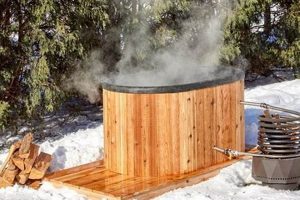A do-it-yourself project involving the construction of a device for smoking food, typically meat, using wood as the primary fuel source. This undertaking involves designing and building a chamber where food can be exposed to smoke generated from smoldering wood. An example is repurposing a metal drum or constructing a smoker from bricks and mortar.
Creating such a device offers the advantage of cost savings compared to purchasing a commercially manufactured smoker. It also allows for customization, enabling builders to tailor the design and features to their specific needs and preferences. Historically, this practice reflects a tradition of resourcefulness and self-sufficiency, particularly in communities where access to manufactured goods was limited.
The subsequent sections will explore various designs, construction methods, safety considerations, and wood selection guidelines relevant to building a food smoking apparatus. Further discussion will address temperature control and operational best practices for achieving optimal smoking results.
Essential Construction and Operational Guidance
The following recommendations provide crucial insights for successfully constructing and operating a homemade smoking apparatus. Adherence to these guidelines will improve both the quality of the smoked product and the overall safety of the undertaking.
Tip 1: Material Selection: Utilize materials that are food-grade and heat-resistant. Avoid galvanized steel or other potentially toxic substances that may leach into the food during the smoking process. Stainless steel or uncoated steel is preferable.
Tip 2: Ventilation Design: Ensure adequate airflow through the smoking chamber. Insufficient ventilation will result in incomplete combustion and undesirable smoke composition. Design intake and exhaust vents that are adjustable to control temperature and smoke density.
Tip 3: Temperature Monitoring: Integrate a reliable temperature gauge into the smoker’s design. Consistent temperature control is vital for effective and safe food smoking. Monitor internal food temperature using a separate probe thermometer.
Tip 4: Wood Selection: Choose hardwoods that are seasoned but not completely dry. Green wood produces excessive smoke and creosote. Avoid softwoods, which contain resins that can impart undesirable flavors. Fruit woods, hickory, and oak are generally recommended.
Tip 5: Smoke Management: Maintain a consistent, thin blue smoke. White, billowing smoke indicates incomplete combustion and can result in a bitter taste. Adjust airflow and wood quantity to achieve optimal smoke conditions.
Tip 6: Placement and Stability: Position the smoker on a level, non-combustible surface away from flammable materials. Secure the structure to prevent tipping, especially in windy conditions.
Tip 7: Regular Cleaning: Remove accumulated ash and creosote from the smoking chamber and vents regularly. This maintenance will improve airflow, reduce fire hazards, and prevent off-flavors in subsequent smoking sessions.
Implementing these considerations enhances the safety, efficiency, and overall success of building and utilizing a custom food smoking device. Attention to detail throughout the construction and operational phases yields superior results.
The subsequent section will address advanced techniques and strategies for refining the smoking process and achieving consistent, high-quality outcomes.
1. Material Selection
The selection of appropriate materials is paramount in the construction of a food smoking device. The materials chosen directly impact the safety, durability, and performance of the smoking apparatus and, consequently, the quality of the smoked food. Inadequate material selection can lead to structural failure, contamination of food, or inefficient operation.
- Food-Grade Compliance
Materials in direct contact with food or smoke must be food-grade to prevent the leaching of harmful substances. Stainless steel is a common and acceptable choice, as it is corrosion-resistant and does not impart unwanted flavors. Conversely, galvanized steel is unsuitable due to the release of zinc oxide at elevated temperatures, posing a health risk. The interior surfaces of the smoking chamber, cooking grates, and any components that contact the food should be constructed from approved food-grade materials.
- Heat Resistance and Insulation
The smoking device must withstand high temperatures without degrading or releasing harmful fumes. Steel, cast iron, and refractory brick are examples of heat-resistant materials. Insulation is also a critical factor, impacting temperature consistency and fuel efficiency. Materials like firebrick or ceramic fiber blankets can be used to insulate the smoking chamber, reducing heat loss and maintaining a stable internal temperature. The choice of insulation impacts the efficiency and safety of the entire system.
- Structural Integrity and Longevity
The structural components of the smoking device must be robust enough to support the weight of the food, withstand repeated heating and cooling cycles, and resist corrosion. Heavy-gauge steel, reinforced welds, and durable fasteners are essential for longevity. Neglecting structural integrity can result in premature failure of the smoker, posing safety risks and requiring costly repairs. A well-constructed smoker should last for years with proper maintenance, so selecting high-quality structural materials is essential.
- Corrosion Resistance
The smoking environment, characterized by moisture, smoke, and acidic byproducts of combustion, is highly corrosive. Materials prone to rust or corrosion will degrade over time, potentially contaminating the food and compromising the structural integrity of the smoker. Stainless steel and certain types of coated steel offer excellent corrosion resistance. Regular maintenance, such as cleaning and applying protective coatings, can further extend the lifespan of the smoker and ensure safe operation.
The careful consideration and application of these material properties are fundamental to the successful construction of a food smoking apparatus. Each material selection decision contributes to the overall safety, efficiency, and longevity of the device, influencing the quality of the smoked food produced. A poorly chosen material can negate the benefits of an otherwise well-designed smoking system. Therefore, thorough research and careful material selection are crucial steps in the creation process.
2. Airflow Dynamics
In the context of a do-it-yourself wood smoker, airflow dynamics represent a critical factor influencing combustion efficiency, temperature regulation, and ultimately, the quality of the smoked product. The controlled movement of air through the smoker’s combustion chamber and cooking area dictates the rate at which the wood burns, the distribution of heat, and the removal of exhaust gases. Insufficient airflow leads to incomplete combustion, resulting in sooty smoke that imparts a bitter taste to the food. Conversely, excessive airflow accelerates combustion, causing rapid temperature increases and potentially drying out the food. A well-designed smoker incorporates adjustable air intakes and exhaust vents to provide precise control over these parameters. For instance, a smoker with restricted airflow may smolder slowly, producing dense, acrid smoke, while one with unrestricted airflow may burn through wood quickly, generating high heat but little smoke flavor.
The practical application of airflow principles in a homemade smoker involves careful consideration of vent placement and sizing. The air intake, typically located near the firebox, supplies oxygen for combustion. Its size must be sufficient to sustain a steady burn but not so large as to create excessive draft. The exhaust vent, situated above the cooking area, allows smoke and hot air to escape. Its position and size influence the temperature gradient within the smoker and the rate at which smoke circulates around the food. Real-world examples include smokers utilizing chimney extensions to enhance draft and smokers employing baffled exhaust systems to promote even smoke distribution. These design features aim to create a stable and predictable smoking environment.
Understanding airflow dynamics enables builders to optimize the performance of their homemade food smoking devices. Controlling airflow requires balancing oxygen supply and exhaust removal to achieve the desired temperature and smoke density. Challenges often arise in maintaining consistent airflow across varying weather conditions. Adjustments to vent settings are frequently necessary to compensate for wind and ambient temperature fluctuations. Mastering this aspect is crucial for consistently producing high-quality smoked food. By manipulating airflow, builders can tailor the smoking process to achieve specific flavor profiles and textures.
3. Temperature Control
Temperature control is fundamental to the successful operation of a food smoking apparatus. In a homemade wood smoker, consistent temperature regulation is paramount for achieving even cooking, desirable smoke penetration, and preventing the growth of harmful bacteria. Insufficient temperature results in prolonged cooking times, increasing the risk of foodborne illness. Excessive temperature causes uneven cooking, resulting in dry or burnt exteriors and undercooked interiors. A poorly regulated temperature environment undermines the entire smoking process. For example, a fluctuating temperature in a meat smoker can cause collagen to break down inconsistently, leading to a tough final product.
Achieving precise temperature control in a wood smoker typically involves managing airflow, fuel quantity, and insulation. Airflow adjustments, through intake and exhaust vents, regulate the rate of combustion and heat transfer within the smoker. Precise control of the fuel quantity, typically wood or charcoal, sustains a consistent heat output. Insulation, achieved through materials like firebrick or ceramic fiber blankets, minimizes heat loss and maintains a stable internal temperature. Many experienced food smokers utilize water pans to moderate temperature fluctuations and maintain humidity within the smoking chamber. Furthermore, continuous monitoring of internal temperature via accurate thermometers is crucial for maintaining desired conditions. This combination of methods allows for consistent cooking and desired smoke penetration.
Maintaining stable temperatures in a homemade wood smoker can be challenging due to variations in weather, fuel quality, and smoker design. However, understanding and implementing effective temperature control strategies is essential for producing safe and high-quality smoked food. By carefully managing airflow, fuel, and insulation, and by monitoring temperature, builders can overcome these challenges and achieve consistent results. Temperature control represents a cornerstone of successful food smoking.
4. Wood Variety
The selection of wood is a critical determinant in the flavor profile imparted to food smoked in a self-constructed smoker. The specific type of wood significantly influences the aroma, taste, and overall sensory experience of the finished product. Choosing wood appropriate for the intended flavor is essential for a successful smoking endeavor.
- Hardwood vs. Softwood Characteristics
Hardwoods, such as oak, hickory, and fruitwoods (apple, cherry), are generally preferred for smoking due to their lower resin content. Softwoods, like pine and fir, contain resins that produce acrid smoke and can contaminate food. For example, using oak provides a robust, smoky flavor suitable for beef, while applewood lends a subtle sweetness that complements pork and poultry. The density and composition of the wood directly affect the smoke’s flavor characteristics and its suitability for different types of food.
- Flavor Profiles of Common Wood Types
Different wood varieties impart distinct flavor notes to smoked foods. Hickory delivers a strong, bacon-like flavor, making it ideal for ribs and pork shoulder. Mesquite offers a bold, earthy flavor often used in Southwestern cuisine. Pecan provides a milder, nuttier flavor compared to hickory. Understanding these flavor nuances allows builders to tailor their wood choice to match the intended culinary outcome. The flavor profile of the wood influences the final product and requires careful consideration.
- Wood Moisture Content and Smoke Quality
The moisture content of the wood significantly affects the quality of the smoke. Seasoned wood, with a moisture content of approximately 20%, produces clean, flavorful smoke. Green wood, with higher moisture levels, generates excessive steam and acrid smoke due to incomplete combustion. Conversely, overly dry wood burns too quickly, producing high heat but little smoke. Properly seasoned wood is crucial for achieving optimal smoke quality and preventing undesirable flavors. The management of moisture in wood determines the smoke and heat output.
- Wood Size and Combustion Rate
The size and shape of the wood used impact the combustion rate and smoke production. Wood chunks and splits are commonly used for sustained smoking, while wood chips are better suited for shorter smoking sessions. Smaller pieces burn more quickly, creating intense bursts of smoke, whereas larger pieces smolder for extended periods. The selected wood size influences the burn characteristics, the duration of smoking, and the consistency of smoke production within the smoking device. Different sizes of wood can be selected for different stages of the smoking process.
The selection of wood for a self-built smoker represents a critical element in achieving desired results. The careful consideration of wood type, flavor profile, moisture content, and size enables builders to optimize the smoking process and produce consistently flavorful and high-quality smoked foods. Mastery of wood selection enhances the overall smoking experience and allows for culinary creativity. The integration of these factors determines the success and quality of any “diy wood smoker” project.
5. Structure Integrity
The structural integrity of a homemade wood smoker is inextricably linked to its safe and effective operation. It dictates the device’s ability to withstand the stresses of repeated heating and cooling cycles, the weight of the food being smoked, and the external forces exerted by weather conditions. Compromised structural integrity presents significant safety hazards, including the potential for collapse, fire, and burns. A smoker constructed with insufficient structural support may warp, buckle, or fail catastrophically, leading to property damage and potential injury. For instance, a smoker built from thin-gauge metal without adequate bracing can deform under heat, creating gaps that compromise temperature control and allow smoke to escape uncontrollably.
Ensuring structural integrity in a do-it-yourself wood smoker involves careful planning and execution. Material selection is paramount; the use of heavy-gauge steel, reinforced welds, and durable fasteners is crucial for creating a robust and long-lasting structure. The design must account for the anticipated load and stress points. For example, a smoker with a large cooking area requires a sturdy frame to support the weight of the grates and the food being smoked. Proper welding techniques are essential for creating strong and durable joints. Furthermore, the smoker should be designed to resist corrosion, as the corrosive environment generated by smoke and moisture can weaken the structure over time. Regular inspections and maintenance are vital for identifying and addressing potential structural weaknesses before they lead to failure. This includes checking for rust, cracks, and loose fasteners.
In summary, the structural integrity of a homemade wood smoker is a non-negotiable requirement for safe and reliable operation. It influences the smoker’s longevity, efficiency, and overall performance. While aesthetic design and functionality are important considerations, prioritizing structural soundness is paramount. Compromising on structural integrity, even for cost savings or convenience, can have severe consequences. Adhering to sound engineering principles and utilizing appropriate materials and construction techniques are critical for building a durable and safe smoking device.
Frequently Asked Questions
This section addresses common inquiries regarding the design, construction, and safe operation of a homemade wood smoker. It aims to provide clear, concise answers based on established principles of engineering and food safety.
Question 1: What are the essential considerations for selecting materials for a do-it-yourself wood smoker?
Material selection mandates prioritizing food-grade compliance, heat resistance, structural integrity, and corrosion resistance. Food-contact surfaces require materials like stainless steel to prevent contamination. The entire structure must endure high temperatures without deformation. Galvanized steel is strictly prohibited due to the risk of toxic zinc oxide release.
Question 2: How does airflow impact the performance of a homemade smoker, and how should it be managed?
Airflow is crucial for combustion efficiency, temperature regulation, and smoke distribution. Adequate intake and exhaust vents are necessary to facilitate complete combustion and prevent acrid smoke. Adjustable vents allow for precise temperature control and adaptation to varying weather conditions.
Question 3: What are the primary methods for maintaining consistent temperature within a DIY wood smoker?
Temperature stability is achieved through a combination of airflow management, fuel regulation, and insulation. Adjusting vent openings controls combustion rate. Using seasoned wood with a consistent moisture content stabilizes fuel output. Insulation minimizes heat loss. Monitoring with reliable thermometers is essential.
Question 4: What types of wood are best suited for smoking food, and why?
Hardwoods, such as oak, hickory, and fruitwoods, are generally preferred. These woods possess lower resin content compared to softwoods, resulting in cleaner, more flavorful smoke. The selection of specific wood should align with the desired flavor profile for the food being smoked.
Question 5: What safety precautions should be observed during the construction and operation of a homemade wood smoker?
Safety protocols include using appropriate personal protective equipment (PPE) during construction, positioning the smoker on a non-combustible surface away from flammable materials, and ensuring adequate ventilation to prevent carbon monoxide buildup. Regular cleaning to remove creosote is also essential.
Question 6: How can the structural integrity of a DIY wood smoker be ensured over time?
Structural integrity requires robust material selection, sound welding practices, and corrosion-resistant coatings. Regular inspections for rust, cracks, and loose fasteners are necessary. Reinforcing weak points and addressing corrosion promptly extends the lifespan of the smoker.
These FAQs provide foundational guidance for those undertaking a “diy wood smoker” project. Proper planning, material selection, and adherence to safety guidelines are essential for a successful and safe outcome.
The subsequent section will delve into advanced topics, including smoker modifications and fine-tuning techniques.
Conclusion
The preceding sections have comprehensively explored the multifaceted aspects of constructing a diy wood smoker. The discourse encompassed material selection, airflow dynamics, temperature control, wood varieties, structural integrity, and safety considerations. Effective implementation of these principles is fundamental to the creation of a functional and safe food smoking device.
The information presented serves as a foundation for informed decision-making. It empowers builders to approach the project with a clear understanding of the challenges and opportunities inherent in crafting a custom food smoking apparatus. Diligent application of these guidelines promotes responsible design and construction practices, enhancing the likelihood of achieving consistent, high-quality smoking results and ensuring user safety.




![[DIY Guide] Easy DIY Wood Window Shutters You Can Build! The DIY Hub: Creative Crafts, Repairs & Life Hacks [DIY Guide] Easy DIY Wood Window Shutters You Can Build! | The DIY Hub: Creative Crafts, Repairs & Life Hacks](https://craftingdiycenter.com/wp-content/uploads/2025/07/th-3579-300x200.jpg)


